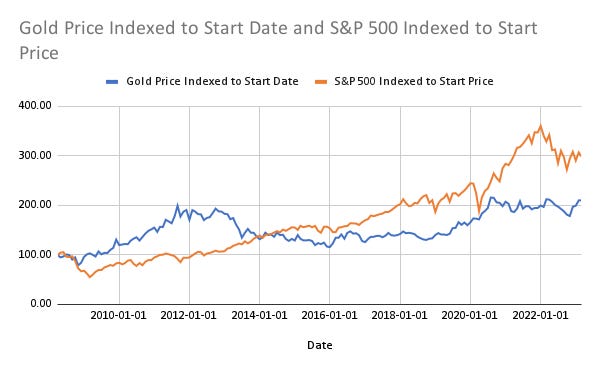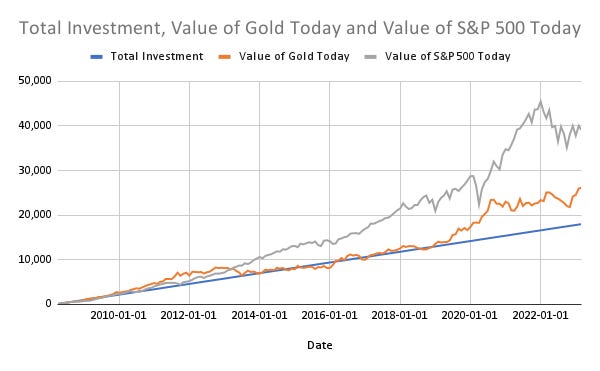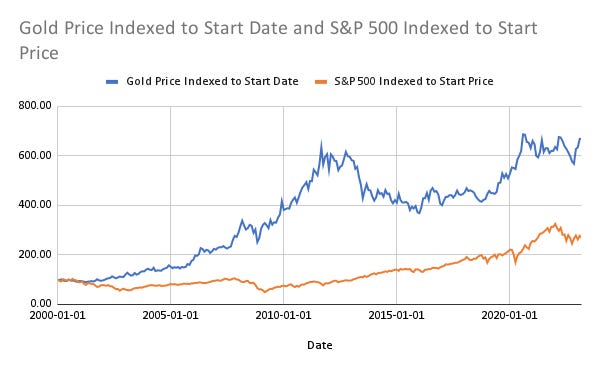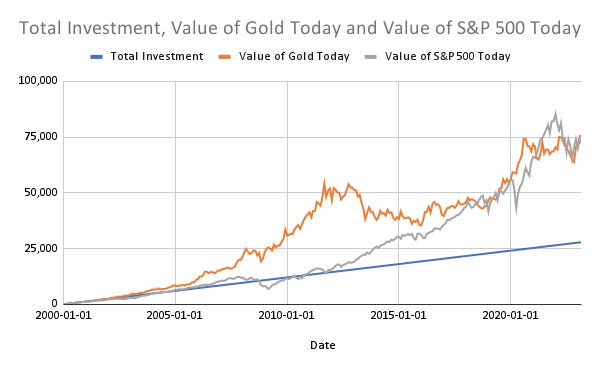Gold as a hedge to equities
"Gold is the ultimate treasure that transcends time and generations" - ChatGPT
Careful observers must have noticed that my coffee can portfolio has a small allocation in NYSEARCA:GLD, which is none other than an ETF that holds Gold as its sole asset, in physical bullion form. This post is going to talk a little bit about why I have that allocation and my thoughts on Gold and other Gold-like investments.
Gold has been appreciating in value for thousands of years. Throughout history, gold has been used as a store of value and a hedge against inflation and economic uncertainty. Today, gold continues to be a valuable asset and is widely traded on global markets.
If you ask ChatGPT to give you phrases on Gold, here are 5 it gave me:
Gold is not just a precious metal, it's a symbol of excellence.
Gold is the currency of kings, the standard of the world.
Investing in gold is like investing in a piece of history that never loses its value.
Gold may be a heavy metal, but it's worth its weight in wealth.
Gold is the ultimate treasure that transcends time and generations.
Gold is an interesting investment vehicle. When you invest in Gold, there are no earnings, no capital expenditures, no sales etc to keep track of, and Gold provides no ongoing yield from holding it. So, Gold is primarily held as a price appreciation asset. However, Gold acts as a interesting hedge to stock markets during times when either the market goes down, or goes sideways.
In the last 15 years
Like all other stock analysis that I do, let’s look at Gold over the past 15 years. Above is the chart covering past 15 years of Gold prices and S&P 500 (indexed to prices from 2008-03-01, i.e. 15 years ago) and you can clearly see the inverse correlation between the two instruments. During phases like 2010 to 2014, Gold was on an absolute tear (in fact, its growth phase commenced somewhere a bit earlier - in 2006 or so. We will come to this later)
Systematic investing in Gold vs S&P 500
If you had chosen to invest a $100 each month in Gold and S&P 500 for the past 15 years, you will today end up with 4.81% p.a. return on Gold, vs 9.76% p.a. on S&P 500 before dividends, so clearly, in the long run, S&P 500 has outperformed. But during those 15 years, there was a period of 3+ years, from September 2009 to December 2012, when the same strategy was returning 15%+ on Gold on compounded basis, while S&P 500 was doing between negative returns and 15%, also on compounded basis. So in that time period, S&P 500’s peak performance was Gold’s worst performance!!
If you need to have a hedge, an asset class that outperforms your core investment holdings by a lot when needed, while not underperforming it by much during other times, is a good instrument to hold.
These comparisons with S&P 500 are without dividends included. With the dividends included, S&P outshines gold, but that doesn’t take away from the core argument I am making here.
Since the turn of the century
Let’s now expand these charts a little bit further back and go all the way to the turn of the century. The graphs get a lot more interesting..
Gold in fact has been outperforming S&P 500 over the past 20 years. In fact, large part of its outperformance came between 2005 and 2013 after which gold has been range bound.
Similarly, on a systematic investment basis, over the past 22+ years, gold and S&P 500 are almost neck and neck. Once dividends are included, S&P will edge ahead by some margin, but again, it is clear that Gold has very good hedging properties and must be considered as a valuable option in that direction.
How to hold Gold?
Gold is exceptionally costly to buy and hold in its physical form. Between VAT, and sales margins, and wastage & making costs, Gold in jewellery form can be extremely costly - sometimes as much as 35-50% more than the intrinsic value of Gold held in the jewellery itself, and you will likely lose a little bit of that value (<5%) when you go to sell it back. However, if you choose to buy Gold in its bullion form, you can likely buy at much smaller cost (as low as <3-5%), but these need to be kept safe, and if you choose to store it in paid lockers, then that adds to the cost of holding Gold.
Instead, I have chosen to hold Gold in its electronic form - through the SPDR GLD ETF. The ETF also holds gold in bullion form, but because of their scale, they can buy, store and insure this bullion at a much better price than individual investors can. The ETF charges a steep 0.4% p.a. in terms of fees but it is among the best options to hold Gold. On top of it being easy to buy and hold, my broker treats it like any other holding, which means I also get margin capability on those holdings, just in case I feel adventurous in taking outsized bets from time to time - this is an option you won’t get in physical forms. I like that flexibility.
How much should Gold represents in your portfolio?
This is the most debatable bit. Some would argue that for the hedge to be effective, it must be about 20% or so, which makes sense at face value. However, if you are in your accumulation phase of financial planning, and can stomach some volatility and don’t need the security of a hedge, perhaps you can keep it as low as 5%.
Personally I intend to slowly increase my holdings in Gold to about 5% and leave it there. I will reconsider the holdings from time to time and perhaps find a good reason to increase it in the future, but for now that’s the aim.
For those interested in the raw data and analysis used in this post, head over here.
Programming Note: I am in the final stages of putting together performance metrics for the coffee can portfolio and will share it next week - seems to be a good time to do so, since we have been on this substack journey together for 3 months now. In the meanwhile, if you find this substack interesting, please share it with like minded investor friends.







Nice article though backward looking. Would be helpfull to have an understanding of factors that drove gold prices and how likely they are to continue over next 20 years. In general what performs well for one decade usually turns into a dog for next decade.